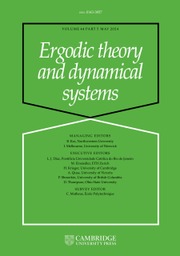No CrossRef data available.
Article contents
Some hyperbolicity revisited and robust transitivity
Published online by Cambridge University Press: 23 June 2025
Abstract
In this article, we revisit the notion of some hyperbolicity introduced by Pujals and Sambarino [A sufficient condition for robustly minimal foliations. Ergod. Th. & Dynam. Sys. 26(1) (2006), 281–289]. We present a more general definition that, in particular, can be applied to the symplectic context (something that was not possible for the previous one). As an application, we construct  $C^1$ robustly transitive derived from Anosov diffeomorphisms with mixed behaviour on centre leaves.
$C^1$ robustly transitive derived from Anosov diffeomorphisms with mixed behaviour on centre leaves.
Information
- Type
- Original Article
- Information
- Copyright
- © The Author(s), 2025. Published by Cambridge University Press
References
Anosov, D. V.. Geodesic flows on closed Riemann manifolds with negative curvature. Proc. Steklov Inst. Math. 90 (1967), 1–235; Engl. transl. (American Mathematical Society, Providence, RI, 1969).Google Scholar
Berger, P. and Carrasco, P.. Non-uniformly hyperbolic diffeomorphisms derived from the standard map. Comm. Math. Phys. 329 (2014), 239–262.CrossRefGoogle Scholar
Bonatti, C. and Díaz, L. J.. Persistent nonhyperbolic transitive diffeomorphisms. Ann. of Math. (2) 143 (1996), 357–396.CrossRefGoogle Scholar
Bonatti, C. and Viana, M.. SRB measures for partially hyperbolic systems whose central direction is mostly contracting. Israel J. Math. 115 (2000), 157–193.CrossRefGoogle Scholar
Bonk, M. and Kleiner, B.. Rigidity for quasi-Möbius group actions. J. Differential Geom. 61 (2002), 81–106.CrossRefGoogle Scholar
Carrasco, P. and Obata, D.. A new example of robustly transitive diffeomorphism. Math. Res. Lett. 28(3) (2021), 665–679.CrossRefGoogle Scholar
Cerminara, M. and Lewowicz, J.. Some open problems concerning expansive systems. Rend. Istit. Mat. Univ. Trieste 42 (2010), 129–141.Google Scholar
Fisher, T., Potrie, R. and Sambarino, M.. Dynamical coherence of partially hyperbolic diffeomorphisms of tori isotopic to Anosov. Math. Z. 278 (2014), 149–168.CrossRefGoogle Scholar
Franks, J.. Anosov diffeomorphisms. Proc. Sympos. Pure Math. 14 (1970), 61–93.CrossRefGoogle Scholar
Franks, J.. Necessary conditions for stability of diffeomorphisms. Trans. Amer. Math. Soc. 158(2) (1971), 301–308.CrossRefGoogle Scholar
Hirsch, M., Pugh, C. and Shub, M.. Invariant Manifolds (Lecture Notes in Mathematics, 583). Springer, Berlin, 1977.CrossRefGoogle Scholar
Leguil, M. and Zhang, Z..
 ${C}^r$
-prevalence of stable ergodicity for a class of partially hyperbolic systems. J. Eur. Math. Soc. (JEMS) 24(9) (2022), 3379–3438.CrossRefGoogle Scholar
${C}^r$
-prevalence of stable ergodicity for a class of partially hyperbolic systems. J. Eur. Math. Soc. (JEMS) 24(9) (2022), 3379–3438.CrossRefGoogle Scholar
Lewowicz, J.. Lyapunov functions and topological stability. J. Differential Equations 38 (1980), 192–209.CrossRefGoogle Scholar
Mañé, R.. Contributions to the stability conjecture. Topology 17(4) (1978), 383–396.CrossRefGoogle Scholar
Potrie, R.. Partially hyperbolicity and attracting regions in 3-dimensional manifolds. PhD Thesis, 2012. https://arxiv.org/abs/1207.1822.Google Scholar
Pujals, E. and Sambarino, M.. A sufficient condition for robustly minimal foliations. Ergod. Th. & Dynam. Sys. 26(1) (2006), 281–289.CrossRefGoogle Scholar
Shub, M.. Topological transitive diffeomorphism on
 ${T}^4$
. Proc. Symp. on Differential Equations and Dynamical Systems (Lecture Notes in Mathematics, 206). Springer, Berlin, 1971, pp. 39–40.CrossRefGoogle Scholar
${T}^4$
. Proc. Symp. on Differential Equations and Dynamical Systems (Lecture Notes in Mathematics, 206). Springer, Berlin, 1971, pp. 39–40.CrossRefGoogle Scholar


